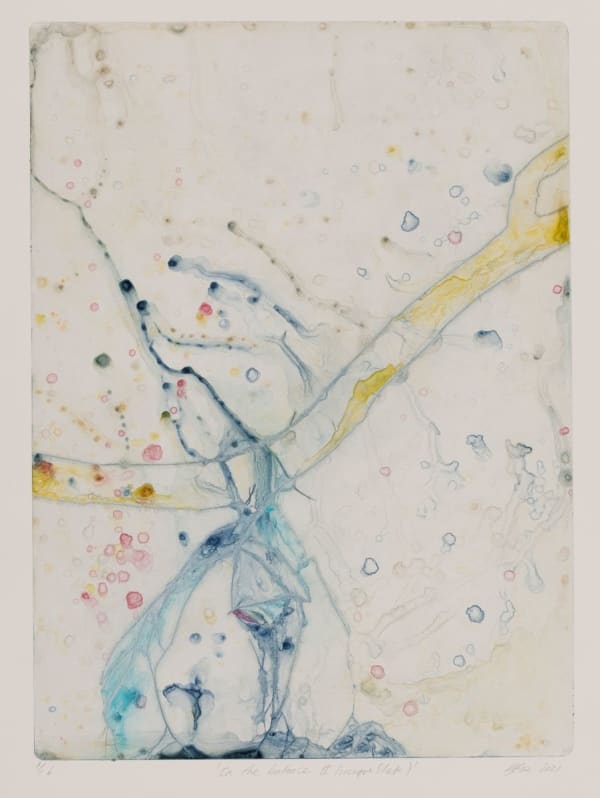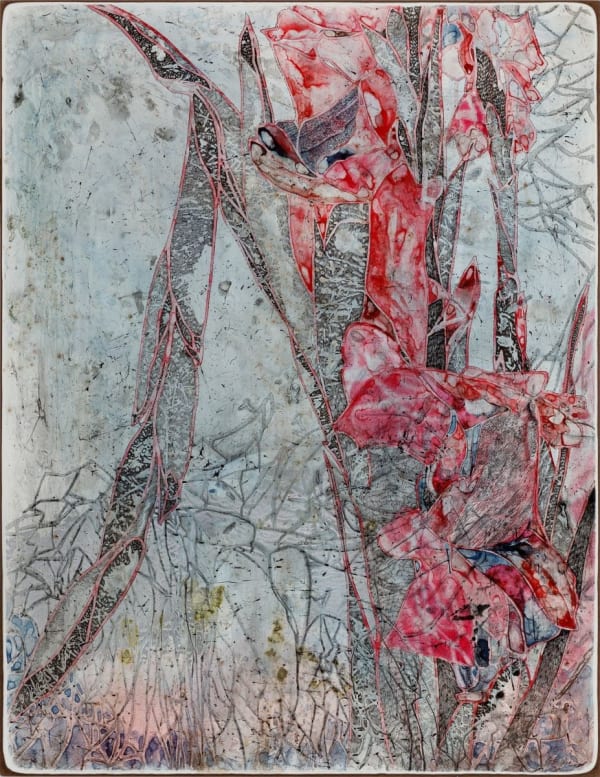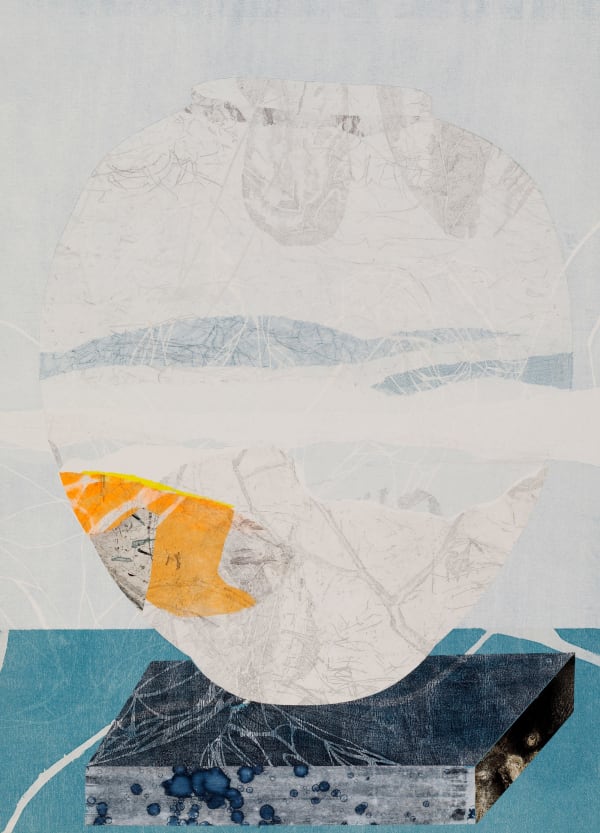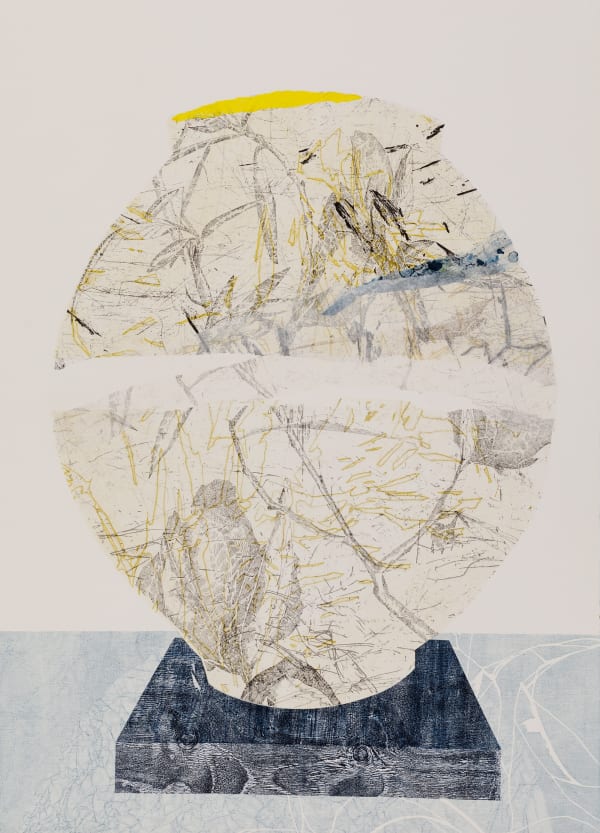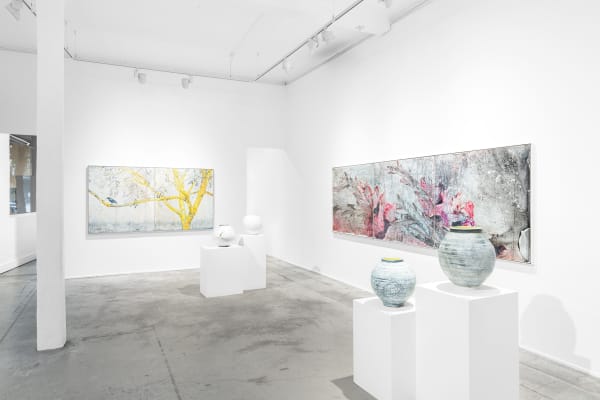Belinda Fox: Cultivate
-
 Belinda FoxIn The Balance I – B, 2021drypoint monotype (unique state)70 x 49 cm, 78.5 x 57 cm (framed)Sold
Belinda FoxIn The Balance I – B, 2021drypoint monotype (unique state)70 x 49 cm, 78.5 x 57 cm (framed)Sold -
 Belinda FoxIn the Balance I – D, 2021drypoint monotype (unique state)71 x 50 cm, 76.5 x 55 cm (framed)
Belinda FoxIn the Balance I – D, 2021drypoint monotype (unique state)71 x 50 cm, 76.5 x 55 cm (framed) -
 Belinda FoxIn the Balance II – B, 2021drypoint monotype (unique state)71 x 50 cm, 76.5 x 55 cm (framed)
Belinda FoxIn the Balance II – B, 2021drypoint monotype (unique state)71 x 50 cm, 76.5 x 55 cm (framed) -
 Belinda FoxIn The Balance II – B, 2021drypoint monotype (unique state)70 x 49 cm, 78.5 x 57 cm (framed)Sold
Belinda FoxIn The Balance II – B, 2021drypoint monotype (unique state)70 x 49 cm, 78.5 x 57 cm (framed)Sold -
 Belinda FoxIn the Balance II – D, 2021drypoint monotype (unique state)71 x 50 cm, 76.5 x 55 cm (framed)
Belinda FoxIn the Balance II – D, 2021drypoint monotype (unique state)71 x 50 cm, 76.5 x 55 cm (framed) -
 Belinda FoxIn the Balance III – B, 2021drypoint monotype (unique state)71 x 50 cm, 76.5 x 55 cm (framed)
Belinda FoxIn the Balance III – B, 2021drypoint monotype (unique state)71 x 50 cm, 76.5 x 55 cm (framed) -
 Belinda FoxIn the Balance III – D, 2021drypoint monotype (unique state)71 x 50 cm, 76.5 x 55 cm (framed)
Belinda FoxIn the Balance III – D, 2021drypoint monotype (unique state)71 x 50 cm, 76.5 x 55 cm (framed) -
 Belinda FoxIts Imperfections are Admirable, 2021watercolour, graphite, pen, ink & encaustic wax on board120 x 130 cm, 121 x 131 cm (framed)
Belinda FoxIts Imperfections are Admirable, 2021watercolour, graphite, pen, ink & encaustic wax on board120 x 130 cm, 121 x 131 cm (framed) -
 Belinda FoxLead the Way I, 2021watercolour, ink, pen, collage, acrylic spray & encaustic wax on board120 x 390 cm, 121 x 391.5 cm (framed)
Belinda FoxLead the Way I, 2021watercolour, ink, pen, collage, acrylic spray & encaustic wax on board120 x 390 cm, 121 x 391.5 cm (framed) -
 Belinda FoxLead the Way II, 2021watercolour, ink, pen, acrylic spray, collage & encaustic wax on board90 x 70 cm, 91 x 71 cm (framed)
Belinda FoxLead the Way II, 2021watercolour, ink, pen, acrylic spray, collage & encaustic wax on board90 x 70 cm, 91 x 71 cm (framed) -
 Belinda Fox & Neville FrenchMoon Jar I – Cultivate, 2021wheel thrown & altered Porcelain, ceramic pencil with limestone glaze (fired at 1320c)35 x 34 x 34 cm
Belinda Fox & Neville FrenchMoon Jar I – Cultivate, 2021wheel thrown & altered Porcelain, ceramic pencil with limestone glaze (fired at 1320c)35 x 34 x 34 cm -
 Belinda Fox & Neville FrenchMoon Jar II – Husk, 2021wheel thrown & altered Porcelain, slips & oxides with limestone glaze (fired at 1320c)37 x 38 x 36 cm
Belinda Fox & Neville FrenchMoon Jar II – Husk, 2021wheel thrown & altered Porcelain, slips & oxides with limestone glaze (fired at 1320c)37 x 38 x 36 cm -
 Belinda Fox & Neville FrenchMoon Jar III – Cogitate, 2021wheel thrown & porcelaneous stoneware, slips & scraffito with limestone glaze (fired at 1320c)45 x 40 x 40 cm
Belinda Fox & Neville FrenchMoon Jar III – Cogitate, 2021wheel thrown & porcelaneous stoneware, slips & scraffito with limestone glaze (fired at 1320c)45 x 40 x 40 cm -
 Belinda Fox & Neville FrenchMoon Jar IV – Dislocate, 2021wheel thrown & altered Porcelain, inlaid slips with limestone glaze (Fired at 1320c)34 x 33 x 35 cm
Belinda Fox & Neville FrenchMoon Jar IV – Dislocate, 2021wheel thrown & altered Porcelain, inlaid slips with limestone glaze (Fired at 1320c)34 x 33 x 35 cm -
 Belinda Fox & Neville FrenchMoon Jar V (harvest), 2021wheel thrown & altered porcelain, inlaid slips with limestone glaze (fired at 1320c)48 x 39 x 39 cmIn collaboration with Neville French
Belinda Fox & Neville FrenchMoon Jar V (harvest), 2021wheel thrown & altered porcelain, inlaid slips with limestone glaze (fired at 1320c)48 x 39 x 39 cmIn collaboration with Neville French -
 Belinda Fox & Neville FrenchMoon Jar VI – Transient, 2021wheel thrown & altered porcelaneous stoneware, inlaid slips with limestone glaze (fired at 1320c)41 x 38 x 40 cm
Belinda Fox & Neville FrenchMoon Jar VI – Transient, 2021wheel thrown & altered porcelaneous stoneware, inlaid slips with limestone glaze (fired at 1320c)41 x 38 x 40 cm -
 Belinda Fox & Neville FrenchMoon Jar VII, 2021wheel thrown & altered Porcelain, inlaid slips & scgraffito with pencil (fired at 1320c)37 x 38 x 37 cm
Belinda Fox & Neville FrenchMoon Jar VII, 2021wheel thrown & altered Porcelain, inlaid slips & scgraffito with pencil (fired at 1320c)37 x 38 x 37 cm -
 Belinda FoxThe Slight Imbalances Were Visible I, 2021etching, woodcut, stencil & collage on paper100 x 70 cm, 107.5 x 79.5 cm (framed)
Belinda FoxThe Slight Imbalances Were Visible I, 2021etching, woodcut, stencil & collage on paper100 x 70 cm, 107.5 x 79.5 cm (framed) -
 Belinda FoxThe Slight Imbalances Were Visible II, 2021etching, woodcut & collage on paper100 x 70 cm, 107.5 x 79.5 cm (framed)
Belinda FoxThe Slight Imbalances Were Visible II, 2021etching, woodcut & collage on paper100 x 70 cm, 107.5 x 79.5 cm (framed) -
 Belinda FoxThe Slight Imbalances Were Visible III, 2021etching, woodcut & collage on paper100 x 70 cm, 105.5 x 77.5 cm (framed)
Belinda FoxThe Slight Imbalances Were Visible III, 2021etching, woodcut & collage on paper100 x 70 cm, 105.5 x 77.5 cm (framed) -
 Belinda FoxThe Slight Imbalances Were Visible IV, 2021etching, woodcut & collage on paper100 x 70 cm, 105.5 x 77.5 cm (framed)
Belinda FoxThe Slight Imbalances Were Visible IV, 2021etching, woodcut & collage on paper100 x 70 cm, 105.5 x 77.5 cm (framed) -
 Belinda FoxThe Slight Imbalances Were Visible V, 2021etching, woodcut & collage on paper100 x 70 cm, 105.5 x 77.5 cm (framed)
Belinda FoxThe Slight Imbalances Were Visible V, 2021etching, woodcut & collage on paper100 x 70 cm, 105.5 x 77.5 cm (framed) -
 Belinda FoxThe Yellow Flower, 2021watercolour, graphite, pen & ink on board120 x 130 cm, 121 x 131 cm (framed)
Belinda FoxThe Yellow Flower, 2021watercolour, graphite, pen & ink on board120 x 130 cm, 121 x 131 cm (framed) -
 Belinda FoxThe Yellow Tree, 2021watercolour, graphite, pen & ink on board130 x 240 cm, 131 x 241 cm (framed)
Belinda FoxThe Yellow Tree, 2021watercolour, graphite, pen & ink on board130 x 240 cm, 131 x 241 cm (framed) -
 Belinda FoxThe Yellow Tree – Study, 2021watercolour, drawing, pen, pastel, ink & pigment on paper121 x 180 cm, 134 x 189.5 cm (framed)
Belinda FoxThe Yellow Tree – Study, 2021watercolour, drawing, pen, pastel, ink & pigment on paper121 x 180 cm, 134 x 189.5 cm (framed) -
 Belinda Fox & Neville FrenchMoon Jar III (cogitate), 2021wheel thrown & porcelaneous stoneware, slips & sgraffito with limestone glaze (fired at 1320c)45 x 40 x 40 cmSoldIn collaboration with Neville French
Belinda Fox & Neville FrenchMoon Jar III (cogitate), 2021wheel thrown & porcelaneous stoneware, slips & sgraffito with limestone glaze (fired at 1320c)45 x 40 x 40 cmSoldIn collaboration with Neville French -
 Belinda Fox & Neville FrenchMoon Jar IV (dislocate), 2021wheel thrown & altered porcelain, inlaid, limestone glazes (fired at 1320c)34 x 33 x 35 cmSoldIn collaboration with Neville French
Belinda Fox & Neville FrenchMoon Jar IV (dislocate), 2021wheel thrown & altered porcelain, inlaid, limestone glazes (fired at 1320c)34 x 33 x 35 cmSoldIn collaboration with Neville French
Belinda Fox’s exhibition, ‘Cultivate,’ suggests something essential about our present moment. After eight and a half years living abroad, Fox recently uprooted her life and returned to Australia in the heat of Covid. And the reality of this uprooting inevitably migrates into her work. “A lot of the show is about trying to settle, and trying to find the calm within the chaos,” Fox explains. Yet looking across the exhibition and the artist’s prints, paintings, and ceramics, one soon realises that Fox’s search for equilibrium does not reveal itself in an obvious picturing of this experience—rather, it is a pursuit that is embedded in her process and hums at the edge of her artworks. Equilibrium is not forced. Instead, it is gently yet firmly cultivated and sown in each of the Fox’s pieces.
The starting point for Fox’s exhibition was the moon jar. The traditional Korean ceramic’s shimmering white surface resembles its celestial namesake. However, Fox’s moon jar remains distinct from the perfect sphere that we periodically spy in the night sky. In order to create the ceramic, two hemispheres—the top and the bottom of the jar—must be fused together. “The meeting point of the pot is always visible. It’s deliberate,” Fox notes. “It tells you about the making of this perfect-imperfect thing. It shows the history of the pots.” Fox and her collaborator, master ceramicist Neville French, follow this material tradition, by celebrating the idiosyncrasies of each work. But, in many ways, this process of fusing the two ceramic hemispheres moves beyond the physicality of the jar. There is something in this visible suture that analogises the artist’s recent homecoming and the symbolic fusing of her worlds. The tension and yet completeness of the two halves, suggest a dynamic that emerges and remerges throughout the show, as all of Fox’s piece subtly transact in an economy of control and release. “The main goal for me is trying to empty the artwork out until it is something essential,” Fox says. “[It] is so hard to do. I know I’ll spend my life trying to do that. But the moon jar is one of those amazing historical forms that captures that perfect balance.”
Even when Fox turns away from her moon jars, the artist’s quest for that ineffable balance remains. In her large multipaneled painting, The Yellow Tree, we see her hand negotiating this same treacherous dynamic. Here, she pulls the snaking trunk of a yellow walnut tree into existence through a series of delicate and nuanced marks. Yet, as soon as the artist’s brush reaches the tree’s foliage, the detailed precision of the trunk lapses into ghostly leaves and loose forms, which almost threaten to disappear before our eyes. Fox’s divergent mark-making produces an interplay between presence and absence, as forms are both declared and redacted within the shared space of the painting. This dissonance is further echoed by the sharp, and erratic lashes of black that disturb the pale ground of the painted board, infusing it with a kinetic charge. The unusual texture is rendered by a chimney cleaner, which Fox not only brushed over her paintings, but also over her prints and ceramics.
By raking the cleaner’s bristles across her oeuvre, Fox produces a shared visual vocabulary which transcends the division of medium. Or put another way, we can discern some hint of spontaneity in her prints that recalls her jars, which, in turn, reminds us of her paintings. These visible connections hint at the other invisible threads that link and bind Fox’s works together. “It’s almost impossible for me to make one painting, because I’m always thinking about what is next to it,” Fox confesses. Indeed, one gets the sense that everything is connected in Fox’s ‘Cultivate’—and that everything hangs, suspended, in a perfectly-imperfect balance..
Tai Mitsuji


